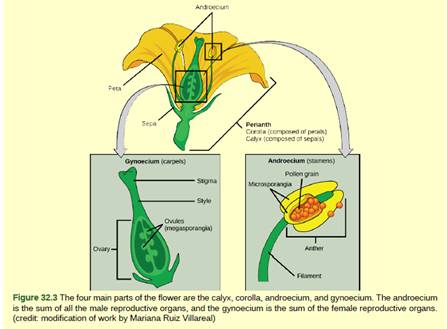
Concept explainers
Figure 32.3 If the anther is missing, what type of reproductive structure will the flower be unable to produce? What term is used to describe a flower that is normally lacking the androecium? What term describes a flower lacking a gynoecium?

To write:
Which type of reproductive system the flower will not be able to produce. The name of the flower that lacks androecium. The name of the flower that lacks gynoecium.
Introduction:
The main parts of the flower are calyx, corolla, androecium and gynoecium. The androecium is representing all the male reproductive parts and gynoecium represents all the female reproductive parts.
Explanation of Solution
Angiosperms are those plants which flower and the seeds produced are covered with carpel. The two distinct stages of plants are gametophyte and sporophyte. Through mitosis, the male and female gametes are produced. These gametes fuse to form a diploid zygote that develops to sporophyte that develops spores by meiosis.
During meiosis, the sporophyte gives rise to the male gamete, the pollen grain from the microspore and the female gamete, egg cell, from the megaspore. The megaspore and microspore cane be present in the same flower or different flowers. As both the spores are haploid, their fusion gives rise to a diploid zygote.
The anther or male gamete is a lobed structure having pollen grains for fusing with the egg cell. If the plant lacks this part, then the male gametes are absent leading to no reproduction. Hence, those flower lacking the androecium is called as a carpellate flower. Those flowers which lack gynoecium part is known as a staminate flower.
The flowers which do not have the anther will not be able to reproduce. The flowers without androecium are called carpellate flower and those without gynoecium is called as a staminate flower.
Want to see more full solutions like this?
Chapter 32 Solutions
Biology 2e
Additional Science Textbook Solutions
College Physics
Becker's World of the Cell (9th Edition)
Campbell Biology in Focus (2nd Edition)
Biological Science (6th Edition)
Essentials of Genetics (9th Edition) - Standalone book
- Figure 14.26 If a flower lacked a megasporangium, what type of gamete would it not be able to form? If it lacked a microsporangium, what type of gamete would not form?arrow_forwardIn flowers, the structures that produce male gametophytes are called _______ ;the strcutures that produce female gametophytes are called _______ . a. pollen grains; flowers c. anthers; stigma b. stamen; carpels d. megaspores; microsporesarrow_forwardFigure 26.15 If a flower lacked a megasporangium, what type of gamete would not form? If the flower lacked a microsporangium, what type of gamete would not form?arrow_forward
- Figure 25.24 Which of the following statements about the fern life cycle is false? Sporangia produce haploid spores. The sporophyte grows from a gametophyte The sporophyte is diploid and the gametophyte is haploid. Sporangia form on the underside of the gametophyte.arrow_forwardIn an angiosperm life cycle, sexual reproduction includes: meiosis within the male gametophyte to produce sperm. meiosis within the female gametophyte to produce eggs. meiosis within the ovary to produce megaspores. fertilization leading to development of microspores. fertilization leading to development of megaspores.arrow_forwardWhich of the following traits characterizes gymnosperms? a. The plants carry exposed seeds on modified leaves. b. Reproductive structures are located in a flower. c. After fertilization, the ovary thickens and forms a fruit. d. The gametophyte is longest phase of the life cycle.arrow_forward
- In a typical angiosperm, what is the sequence of structures encountered by the tip of a growing pollen tube on its way to the egg? ovary → style → stigma stigma → style → ovary ovary→ stigma→ style stigma→ ovary → stylearrow_forwardWhich of the following structures in a flower is not directly involved in reproduction? a. the style b. the stamen c. the sepal d. the antherarrow_forwardLook at the image Describe the color and texture of each part of the plants and indicate the function of each part as well. What is the nature and function of the pedicel and receptacle? Are all parts of the flower separate from each other or are they fused together? Does pollination in this plant occur via wind or an animal vector?arrow_forward
- The term hypocotyl refers to the portion of the embryonic stem that is located below the attachment of the cotyledons. Is the statement true or falsearrow_forwardAngiosperms ( flower bearing ) plants developed after gymnosperms ( cone bearing ) plants during the Mesozoic era Which of the following is a benefit to plants developing the ability to have flowers over cones ? ANSWER CHOICES ARE IN THE PHOTO. thanks.arrow_forwardLabel the parts of the flower in the following illustration.arrow_forward
 Biology 2eBiologyISBN:9781947172517Author:Matthew Douglas, Jung Choi, Mary Ann ClarkPublisher:OpenStax
Biology 2eBiologyISBN:9781947172517Author:Matthew Douglas, Jung Choi, Mary Ann ClarkPublisher:OpenStax Concepts of BiologyBiologyISBN:9781938168116Author:Samantha Fowler, Rebecca Roush, James WisePublisher:OpenStax College
Concepts of BiologyBiologyISBN:9781938168116Author:Samantha Fowler, Rebecca Roush, James WisePublisher:OpenStax College Biology: The Dynamic Science (MindTap Course List)BiologyISBN:9781305389892Author:Peter J. Russell, Paul E. Hertz, Beverly McMillanPublisher:Cengage Learning
Biology: The Dynamic Science (MindTap Course List)BiologyISBN:9781305389892Author:Peter J. Russell, Paul E. Hertz, Beverly McMillanPublisher:Cengage Learning
 Biology Today and Tomorrow without Physiology (Mi...BiologyISBN:9781305117396Author:Cecie Starr, Christine Evers, Lisa StarrPublisher:Cengage Learning
Biology Today and Tomorrow without Physiology (Mi...BiologyISBN:9781305117396Author:Cecie Starr, Christine Evers, Lisa StarrPublisher:Cengage Learning




